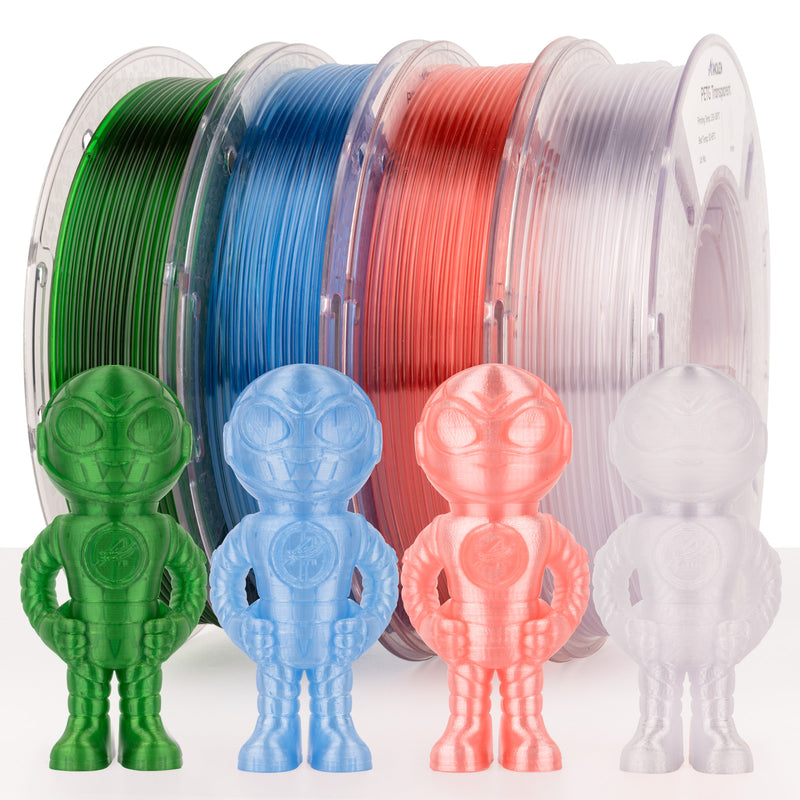Unleash Your Creativity: Discover the Magic of Crystal Clear PETG Filament!
In the vibrant world of 3D printing, the materials you choose can dramatically influence the outcome of your projects. Among the range of options available, PETG transparent filament stands out for its unique properties and versatility. This material not only allows for crystal-clear prints but also opens doors to a myriad of creative possibilities for both hobbyists and professionals. Whether you're looking to create intricate prototypes or stunning artistic pieces, the appeal of PETG filament lies in its ability to transform your imaginative ideas into tangible reality. With its growing popularity in the 3D printing community, many enthusiasts are eager to explore the myriad ways this filament can enhance their craft. Join us as we delve into the fascinating world of PETG transparent filament and discover why it might just be the material you've been searching for!

Understanding PETG Transparent Filament
PETG, or Polyethylene Terephthalate Glycol, is a popular thermoplastic known for its remarkable balance of strength and flexibility. Unlike other materials such as PLA or ABS, PETG offers superior clarity and durability, making it a favorite among 3D printing enthusiasts. One of the key properties of PETG is its resistance to impact and temperature fluctuations, which means prints are less likely to break or warp during use. This makes it an excellent choice for functional prototypes that need to withstand real-world conditions. Furthermore, the transparent variant of PETG allows for stunningly clear prints that can resemble glass, providing endless opportunities for artists and designers. A friend of mine, who loves creating custom light fixtures, swears by PETG for its clarity and strength, claiming that it allows him to bring his intricate designs to life without sacrificing durability.
Applications of PETG Transparent Filament
The versatility of PETG transparent filament extends to various fields, making it a valuable addition to any 3D printing toolkit. In the realm of prototyping, its clarity allows engineers and designers to create models that closely mimic the appearance and functionality of final products. This is particularly useful in industries such as automotive and consumer goods, where visual aesthetics are crucial. Additionally, PETG is a favorite among artists and makers for creating visually appealing sculptures, jewelry, and decorative items. Its ability to produce smooth, glossy finishes enhances the overall aesthetic of any project. Moreover, PETG's strength makes it suitable for functional prints, such as custom housings or components that require transparency, like light covers. A colleague of mine recently used PETG to create a unique lamp shade, and the way the light diffused through the material was simply mesmerizing, showcasing how impactful this filament can be in artistic applications.
Benefits of Using PETG Transparent Filament
One of the standout advantages of PETG transparent filament is its ease of use, making it an ideal choice for both beginners and experienced users. Unlike some filaments that can be finicky and require extensive tuning, PETG is generally forgiving during the printing process. It adheres well to the print bed, reducing the risk of warping and allowing for more reliable prints. Additionally, PETG boasts impressive strength, which means your prints can withstand daily wear and tear, making them perfect for practical applications. The high-quality finish achievable with PETG is another compelling reason to consider this material. The clarity and gloss of the prints can elevate even the simplest designs, inspiring creativity and innovation. Personally, I’ve witnessed friends experiment with PETG for functional and artistic projects, and their excitement at the results is infectious. The ability to create something both beautiful and durable has sparked countless creative ideas among my peers.
Tips for Printing with PETG Transparent Filament
To achieve the best results with PETG transparent filament, there are several practical tips to keep in mind. First, optimal printing temperatures typically range between 230°C to 250°C, so be sure to consult your 3D printer's specifications to find the sweet spot. Proper bed adhesion is crucial, and using a heated bed set to around 70°C can help prevent warping. Some users find that applying a thin layer of glue stick or blue painter's tape can enhance adhesion further. Post-processing is also an essential step if you want to maximize clarity. Techniques such as sanding and polishing can significantly improve the final appearance of your prints, giving them that glass-like finish many desire. A friend of mine has a knack for post-processing and shared some insightful tips on how to make his PETG prints shine, suggesting that even a bit of mild soap and water can do wonders for enhancing transparency. Experimenting with these techniques can lead to remarkable results!
Maximizing Creativity with PETG
PETG transparent filament is truly a game-changer in the world of 3D printing, offering a unique combination of clarity, strength, and ease of use. Its ability to produce stunningly clear prints makes it a favorite among both hobbyists and professionals, while its versatility ensures it can be used in various applications, from prototyping to artistic endeavors. By embracing the magic of PETG, you can unlock new levels of creativity and innovation in your projects. Whether you're crafting functional designs or exploring artistic expressions, PETG transparent filament is a material worth considering for your next 3D printing adventure. So, dive into this exciting material and see where your creativity takes you!







